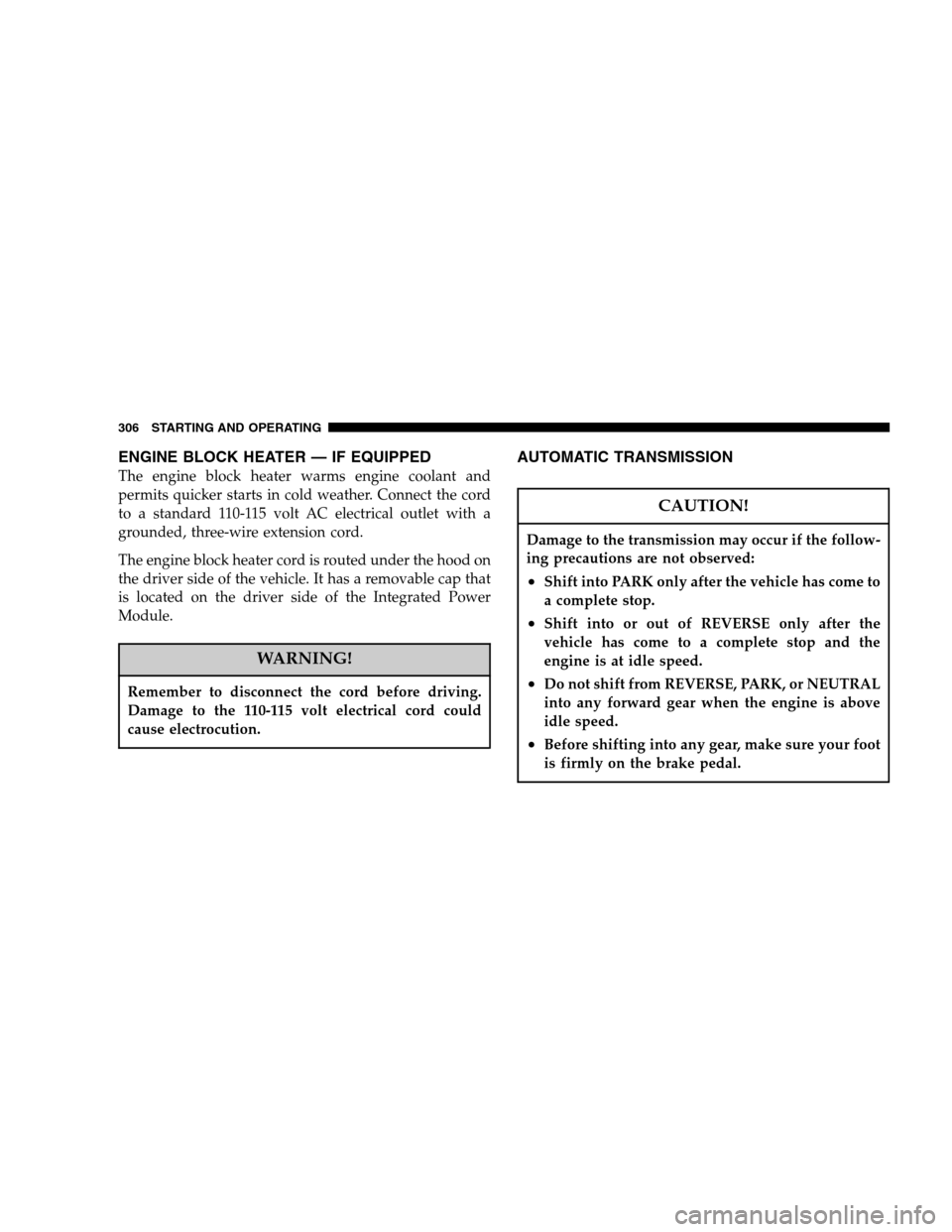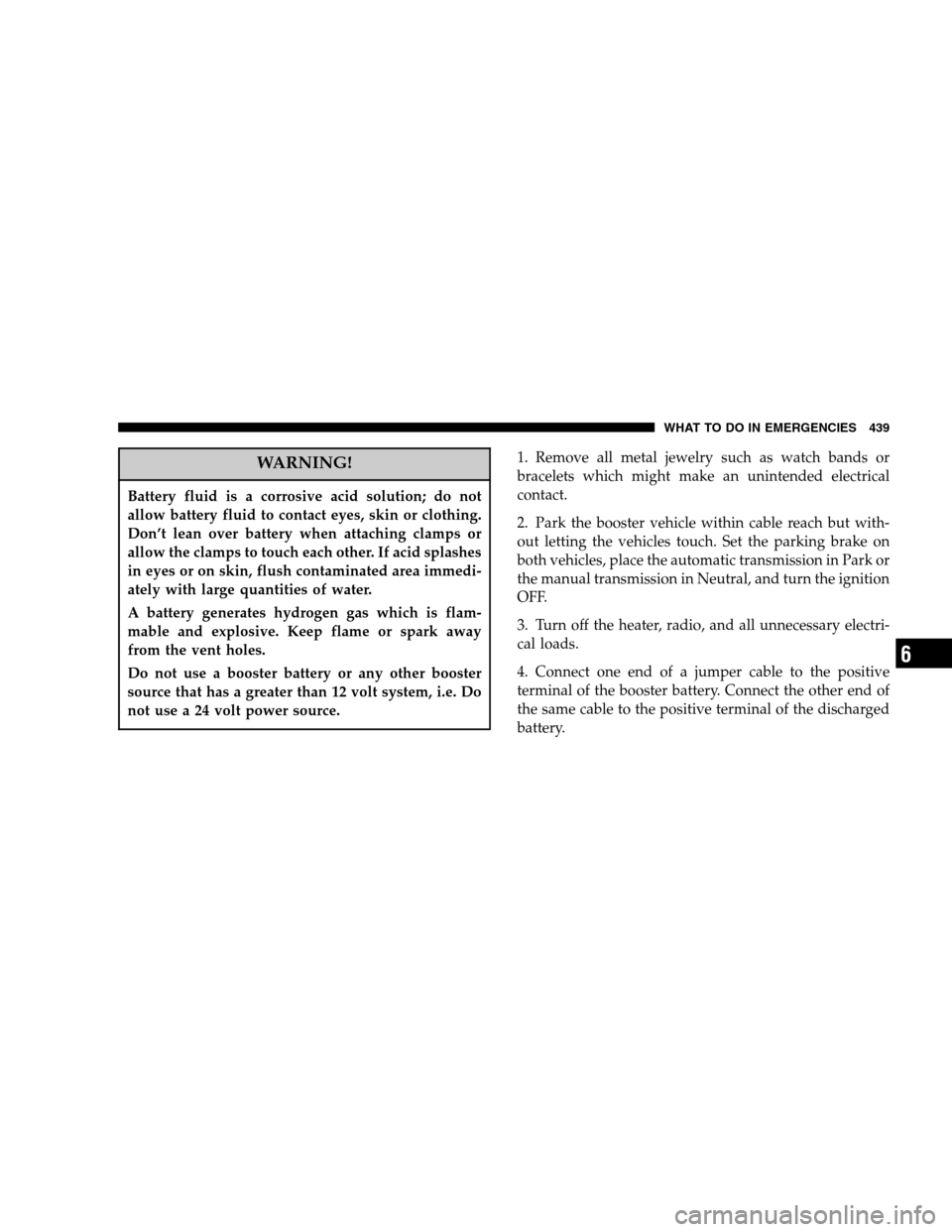Page 6 of 568

WARNINGS AND CAUTIONS
This manual containsWARNINGSagainst operating
procedures which could result in an accident or bodily
injury. It also containsCAUTIONSagainst procedures
which could result in damage to your vehicle. If you do
not read this entire manual you may miss important
information. Observe all Warnings and Cautions.
VAN CONVERSIONS/CAMPERS
The Manufacturer’s Warranty does not apply to body
modifications or special equipment installed by van
conversion/camper manufacturers/ body builders. See
the Warranty information book, Section 2.1.C. Such
equipment includes video monitors, VCRs, heaters,
stoves, refrigerators, etc. For warranty coverage and
service on these items, contact the applicable manufac-
turer.
Operating instructions for the special equipment in-
stalled by the conversion/camper manufacturer should
also be supplied with your vehicle. If these instructions
are missing, please contact your selling dealer for assis-
tance in obtaining replacement documents from the
applicable manufacturer.
6 INTRODUCTION
Page 162 of 568
level, or OFF. The High heat level operates for 30 minutes
(approximate), the Low heat level operates for 30 min-
utes (approximate). The seat heat will also turn OFF
when the ignition is turned OFF. Both of the indicators
ON identifies High heat level. The lower indicator On
only, identifies Low heat level. Flashing indicator lights
on the switch indicate that the Heated Seat System needs
servicing.WARNING!
Persons who are unable to feel pain to the skin
because of advanced age, chronic illness, diabetes,
spinal cord injury, medication, alcohol use, exhaus-
tion or other physical condition must exercise care
when using the seat heater. It may cause burns even
at low temperatures, especially if used for long
periods of time.
Do not place anything on the seat that insulates
against heat, such as a blanket or cushion. This may
cause the seat heater to overheat.
162 UNDERSTANDING THE FEATURES OF YOUR VEHICLE
Page 219 of 568

Safety Checks You Should Make Inside The
Vehicle
Heater Defroster Ducts
Inspect the heater defroster ducts for proper operation.
Check for proper air flow through all defroster ducts. If
there are any question regarding the operation of your
heater defroster ducts, have the system checked by an
authorized dealer
Seat Belts
Inspect the belt system periodically, checking for cuts,
frays and loose parts. Damaged parts must be replaced
immediately. Do not disassemble or modify the system.
Seat belt assemblies must be replaced after an accident if
they have been damaged (bent retractor, torn webbing,
etc.) or if the front airbags have deployed. If there is any
question regarding belt or retractor condition, replace the
belt.
Airbag Light
The light should come on and remain on for 6 to 8
seconds as a bulb check when the ignition switch is first
turned ON. If the light is not lit during starting, see your
authorized dealer. If the light stays on, flickers or comes
on while driving, have the system checked by an autho-
rized dealer. If there is a problem with the airbag light the
seatbelt light will flash.
Safety Checks You Should Make Outside The
Vehicle
Tires
Examine tires for tread wear or uneven wear patterns.
Check for stones, nails, glass or other objects lodged in
the tread.
Inspect for tread cuts or sidewall cracks. Check wheel
nuts for tightness and tires for proper pressure.
UNDERSTANDING THE FEATURES OF YOUR VEHICLE 219
3
Page 224 of 568
▫Satellite Antenna......................279
▫Reception Quality.....................279
�Remote Sound System Controls — If Equipped . . 280
▫Radio Operation......................280
▫Tape Player.........................281
▫CD Player..........................281
�Cassette Tape And Player Maintenance.......281
�Compact Disc Maintenance................282
�Radio Operation And Cellular Phones........283�Climate Controls.......................283
▫Heater Only — If Equipped..............284
▫Air Conditioning And Heating —
If Equipped.........................286
▫Air Conditioning With Dual Zone Temperature
Control — If Equipped.................289
▫Operating Tips.......................293
▫Operating Tips Chart...................296
224 UNDERSTANDING YOUR INSTRUMENT PANEL
Page 284 of 568
Heater Only — If Equipped
The mode control (at the right of the
control panel) can be set in any of the
following positions:NOTE:To improve your selection choices, the system
allows you to operate at intermediate positions between
the major modes. These intermediate positions are iden-
tified by the small dots.
Panel
Outside air flows through the outlets located in the
instrument panel.
Recirculation Modes (Panel or Bi-Level)
Select the recirculation modes when
the outside air contains smoke or
odors. This feature allows for recircu-
lation of interior air only. Air flows
through the panel outlets in this mode.
Air flows through the panel only or
through both the panel and floor vents
depending on the selected mode (panel vs bi-level).
Manual Heating Controls
284 UNDERSTANDING YOUR INSTRUMENT PANEL
Page 297 of 568
STARTING AND OPERATING
CONTENTS
�Starting Procedures – Gas Engines...........302
▫Manual Transmission..................302
▫Automatic Transmission................302
▫Normal Starting......................303
▫If Engine Fails To Start.................303
▫After Starting........................305
�Engine Block Heater — If Equipped.........306
�Automatic Transmission..................306
▫Automatic Transmission With Overdrive.....307�Manual Transmission....................312
▫Manual Transmission — 6 Speed (G56)......313
▫Recommended Vehicle Shift Speeds........314
▫Manual Transmission — 6-Speed (G238).....314
▫Recommended Shift Speeds..............315
▫Downshifting – All Manual Transmissions....315
�Four-Wheel- Drive Operation — If Equipped . . . 316
▫Manually Shifted Transfer Case Operating
Information/Precautions................317
5
Page 306 of 568

ENGINE BLOCK HEATER — IF EQUIPPED
The engine block heater warms engine coolant and
permits quicker starts in cold weather. Connect the cord
to a standard 110-115 volt AC electrical outlet with a
grounded, three-wire extension cord.
The engine block heater cord is routed under the hood on
the driver side of the vehicle. It has a removable cap that
is located on the driver side of the Integrated Power
Module.
WARNING!
Remember to disconnect the cord before driving.
Damage to the 110-115 volt electrical cord could
cause electrocution.
AUTOMATIC TRANSMISSION
CAUTION!
Damage to the transmission may occur if the follow-
ing precautions are not observed:
•Shift into PARK only after the vehicle has come to
a complete stop.
•Shift into or out of REVERSE only after the
vehicle has come to a complete stop and the
engine is at idle speed.
•Do not shift from REVERSE, PARK, or NEUTRAL
into any forward gear when the engine is above
idle speed.
•Before shifting into any gear, make sure your foot
is firmly on the brake pedal.
306 STARTING AND OPERATING
Page 439 of 568

WARNING!
Battery fluid is a corrosive acid solution; do not
allow battery fluid to contact eyes, skin or clothing.
Don’t lean over battery when attaching clamps or
allow the clamps to touch each other. If acid splashes
in eyes or on skin, flush contaminated area immedi-
ately with large quantities of water.
A battery generates hydrogen gas which is flam-
mable and explosive. Keep flame or spark away
from the vent holes.
Do not use a booster battery or any other booster
source that has a greater than 12 volt system, i.e. Do
not use a 24 volt power source.
1. Remove all metal jewelry such as watch bands or
bracelets which might make an unintended electrical
contact.
2. Park the booster vehicle within cable reach but with-
out letting the vehicles touch. Set the parking brake on
both vehicles, place the automatic transmission in Park or
the manual transmission in Neutral, and turn the ignition
OFF.
3. Turn off the heater, radio, and all unnecessary electri-
cal loads.
4. Connect one end of a jumper cable to the positive
terminal of the booster battery. Connect the other end of
the same cable to the positive terminal of the discharged
battery.
WHAT TO DO IN EMERGENCIES 439
6